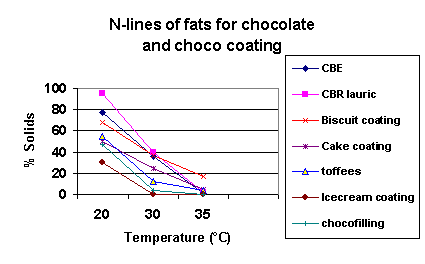| Confectionery
The confectionery area can be divided in chocolate confectionery
and sugar confectionery
Chocolate confectionery
Chocolate consists of cocoa mass, cocoa powder, (milk powder),
sugar and fat
This area shows a large number of different applications:
- Real chocolate with as important characteristics a good snap/bite
and good melting. This means that the N35 should be low (<4)
and the N10 and N20 should be high.
In real chocolate cocoa butter is present as the fat part but
there are also cocoa butter equivalents (CBE) or replacers (CBR)/substitutes
(CBS) available on the market.
- Chocolate coating applications:
- Pralines; high quality fat as with chocolate itself
- Biscuit and wafer coatings
- Cake coatings
- Ice cream coatings
- Others.
- Chocolate fillings
For each application there is an optimal fat, fulfilling the constraints
for acceptable costs.
In principle it can be stated that the steeper the N-line the more
expensive the fat is.
Examples of the N-lines of potential fats for the various applications
are given in the figure below.

Sugar confectionery
For toffees usually butterfat or a vegetable alternative with a
low N35 is used.
Partially hardened laurics or oils can be applied.
When laurics are used care should be taken to avoid the soapy taste
(possible presence of lipase activity e.g. in the ingredients or
in the environment).
Although laurics are widely applied in the confectionery area,
also lauric alternatives are
applied, because laurics are sometimes rather expensive or because
laurics can develop, under special conditions, soapy off-taste.
 Back to top
Back to top
|